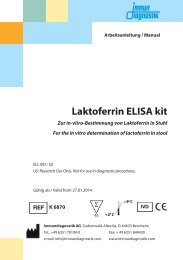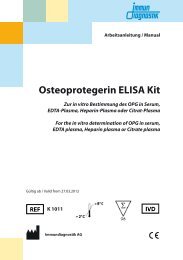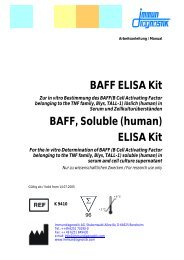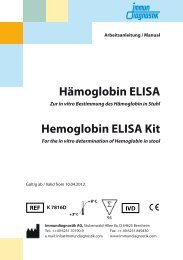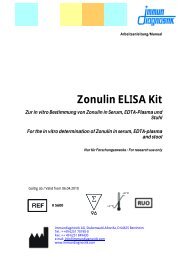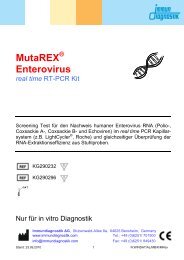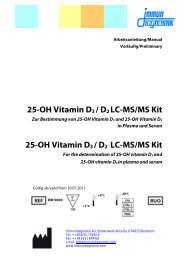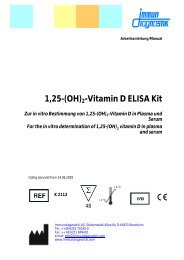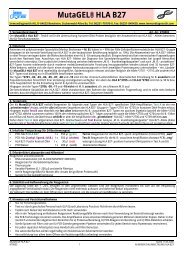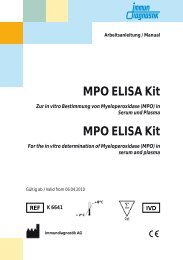Glutathionperoxidase (GPx) MTP Assay Kit ... - bei Immundiagnostik
Glutathionperoxidase (GPx) MTP Assay Kit ... - bei Immundiagnostik
Glutathionperoxidase (GPx) MTP Assay Kit ... - bei Immundiagnostik
You also want an ePaper? Increase the reach of your titles
YUMPU automatically turns print PDFs into web optimized ePapers that Google loves.
Ar<strong>bei</strong>tsanleitung/Manual<br />
<strong>Glutathionperoxidase</strong><br />
(<strong>GPx</strong>) <strong>MTP</strong> <strong>Assay</strong> <strong>Kit</strong><br />
Zur Bestimmung der <strong>GPx</strong>-Aktivität in biologischen Proben<br />
Glutathione peroxidase<br />
(<strong>GPx</strong>) <strong>MTP</strong> <strong>Assay</strong> <strong>Kit</strong><br />
For the determination of <strong>GPx</strong> activity in biological samples<br />
Gültig ab / Valid from 17.07.2012<br />
K 7031<br />
96<br />
<strong>Immundiagnostik</strong> AG, Stubenwald-Allee 8a, D 64625 Bensheim<br />
Tel.: ++49 6251 70190-0<br />
Fax: ++ 49 6251 849430<br />
e.mail: Info@immundiagnostik.com<br />
www.<strong>Immundiagnostik</strong>.com
Ar<strong>bei</strong>tsanleitung/Manual <strong>GPx</strong> – Aktivität/Activity<br />
Inhalt / Content<br />
1. Deutsch<br />
2. English<br />
Weitere Informationen zu unseren Produkten finden Sie auf unserer<br />
Homepage<br />
Additional information about our products is available on our homepage<br />
www.immundiagnostik.com
Ar<strong>bei</strong>tsanleitung/Manual <strong>GPx</strong> – Aktivität/Activity<br />
1. VERWENDUNGSZWECK<br />
Der <strong>Glutathionperoxidase</strong> (<strong>GPx</strong>) <strong>Assay</strong> <strong>Kit</strong> ist für die Bestimmung der<br />
<strong>Glutathionperoxidase</strong> (<strong>GPx</strong>) Aktivität in biologischen Proben und in<br />
Erythrozyten-Lysaten geeignet. Nur für Forschungszwecke.<br />
2. EINLEITUNG<br />
Die <strong>Glutathionperoxidase</strong> (<strong>GPx</strong>) ist eines der wichtigsten antioxidativen<br />
Enzyme für die Entgiftung von reaktiven Sauerstoffspezies in lebenden<br />
Zellen. <strong>GPx</strong> ist verantwortlich für die Aufrechterhaltung der Integrität aller<br />
Zellmembranen gegenüber Schädigungen durch oxidativen Stress. Vor<br />
allem die Lipidkomponenten der Zellmembranen werden durch freie<br />
Radikale zu Lipidperoxiden oxidiert. <strong>GPx</strong> reduziert die Peroxide mit Hilfe von<br />
Glutathion zu Alkoholen und verhindert somit die Bildung von freien<br />
Radikalen.<br />
Die Enzyme der <strong>GPx</strong>-Familie katalysieren die Reduktion von<br />
Wasserstoffperoxiden und Lipidhydroperoxiden zu Wasser und den<br />
entsprechenden stabilen Alkoholen mit Hilfe von zellulärem Glutathion als<br />
reduzierendem Reagenz.<br />
Die meisten zellulären <strong>Glutathionperoxidase</strong>n sind tetramere Enzyme,<br />
bestehend aus vier identischen 22 kDa Monomeren, wo<strong>bei</strong> jede<br />
Untereinheit ein Selenocystein im aktiven Zentrum enthält. Das<br />
Selenocystein gibt ein Elektron direkt an das Peroxidsubstrat ab und wird<br />
dadurch oxidiert. Zudem nutzt das Enzym reduziertes Glutathion als<br />
Elektronendonator um die reduzierte Form des Selenocystein wieder zu<br />
regenerieren. Die <strong>GPx</strong> Enzyme existieren auch als nicht-Selen (nicht-Se)<br />
haltige Enzyme.<br />
Zelluläre <strong>GPx</strong> ist in allen Geweben vorhanden; allerdings können<br />
verschiedene Krankheiten die <strong>GPx</strong>-Konzentration beeinflussen. Ein Anstieg<br />
der <strong>GPx</strong>-Konzentration wurde in Reticulozyten von diabetischen Ratten<br />
nachgewiesen. Der Spiegel normalisierte sich nach Insulin-Gabe. Eine<br />
verminderte <strong>GPx</strong>-Konzentration wurde <strong>bei</strong> Patienten mit Haarzellleukämie<br />
oder Favismus (Krankheit, assoziiert mit einer schweren hämolytischen Krise)<br />
detektiert.<br />
Indikation<br />
� Detoxifikationsmarker<br />
1
Ar<strong>bei</strong>tsanleitung/Manual <strong>GPx</strong> – Aktivität/Activity<br />
3. TESTPRINZIP<br />
Der <strong>Kit</strong> benutzt eine indirekte Bestimmungsmethode. Diese basiert auf der<br />
<strong>GPx</strong>-katalysierten Oxidation von Glutathion (GSH) zu oxidiertem Glutathion<br />
(GSSG), wo<strong>bei</strong> GSSG in einer gekoppelten Reaktion von Glutathionreduktase<br />
(GR) und NADPH (b-Nicotinamid-Adenin-Dinucleotid-Phosphat, reduziert)<br />
wieder zu GSH reduziert wird.<br />
Die Abnahme der NADPH-Absorption <strong>bei</strong> 340 nm während der Oxidation<br />
von NADPH zu NADP+ entspricht der <strong>GPx</strong>-Aktivität, da die <strong>Glutathionperoxidase</strong><br />
der geschwindigkeitslimitierende Faktor der gekoppelten<br />
Reaktion ist:<br />
<strong>GPx</strong><br />
R-OOH + 2 GSH � R-OH + GSSG + H2O<br />
GR<br />
GSSG + NADPH + H+ � 2 GSH + NADP+<br />
<strong>GPx</strong> - <strong>Glutathionperoxidase</strong>, GR - Glutathionreduktase, R-OOH – organisches<br />
Peroxid.<br />
Die Reaktion wird <strong>bei</strong> 25 °C und pH 8.0 durchgeführt und wird durch Zugabe<br />
eines organischen Peroxids, tert-Butylhydroperoxid (t-Bu-OOH), gestartet.<br />
Dieses Substrat eignet sich gut für den <strong>Assay</strong>, da seine spontane Reaktion<br />
mit GSH gering ist, und es wird durch Katalase nicht metabolisiert. Durch die<br />
Reaktion mit tert-Butylhydroperoxid wird die Aktivität der Selen-haltigen<br />
<strong>Glutathionperoxidase</strong> in der Probe ermittelt.<br />
Falls in der Probe auch nicht-Se-haltige Enzyme vermutet werden, kann das<br />
Cumen-Hydroperoxid im Konzentrationbereich von 0.25–1.0 mM als<br />
Substrat eingesetzt werden. Dadurch wird die totale <strong>GPx</strong>-Aktivität (Se- und<br />
nicht-Se-haltige Enzyme) bestimmt. Die Differenz zwischen den Aktivitäten<br />
erhalten mit Cumen-Hydroperoxid und tert-Butylhydroperoxid stellt die<br />
Aktivität der nicht-Se-haltigen <strong>Glutathionperoxidase</strong>n dar.<br />
Eine <strong>GPx</strong>-Unit ist definiert als die Aktivität, die 1 mmol NADPH zu NADP+ pro<br />
Minute <strong>bei</strong> 25°C und pH 8.0 in einer gekoppelten Reaktion in Anwesenheit<br />
von reduziertem Glutathion, Glutathionreduktase und tert-<br />
Butylhydroperoxid umsetzt.<br />
2
Ar<strong>bei</strong>tsanleitung/Manual <strong>GPx</strong> – Aktivität/Activity<br />
4. INHALT DER TESTPACKUNG<br />
Artikel Nr. Inhalt <strong>Kit</strong> Komponenten Menge<br />
K 7031<strong>MTP</strong> PLATE Mikrotiterplatte 12 x 8 wells<br />
K 7031BU ASYBUF <strong>Assay</strong>puffer 2 x 100 ml<br />
K 7031AR ASYREAG <strong>Assay</strong>-Reagenz 4 x 1 vial<br />
K 7031PER PER Peroxidsubstrat, tert-Butylhydroperoxid 100 μl<br />
K 7031RED RED Glutathion-Reduktase 160 μl<br />
5. ERFORDERLICHE LABORGERÄTE UND HILFSMITTEL<br />
� Reinstwasser*<br />
� Präzisionspipetten und Pipettenspitzen für den Einmalgebrauch mit<br />
variablen Volumina von 20 - 1000 μl<br />
� Mehrfach-Dispenser (schrittweise 50 μl und 100 μl) mit 50 μl Disperser-<br />
Tips (2,5 ml)<br />
� Mikrotiterplattenlesegerät geeignet zur Kinetikmessung (zeitliche<br />
Erfassung der OD-Änderung) <strong>bei</strong> 340 nm<br />
*<strong>Immundiagnostik</strong> AG empfiehlt die Verwendung von Reinstwasser nach ISO 3696. Es<br />
handelt sich da<strong>bei</strong> um Wasser des Typs 1, welches frei von ungelösten und kolloidalen<br />
Ionen und organischen Molekülen ist (frei von Partikeln > 0,2 μm) mit einer<br />
elektrischen Leitfähigkeit < 0,055 μS/cm <strong>bei</strong> 25°C (≥18,2 MΩ cm).<br />
6. PROBENVORBEREITUNG<br />
Die Proben mit dem ASYBUF (<strong>Assay</strong>puffer) so verdünnen, dass ein linearer<br />
Messbereich gefunden wird. Dazu müssen verschiedene Verdünnungen<br />
ausgetestet werden. Bei Erythrozyten-Lysaten liegt der Messbereich in etwa<br />
<strong>bei</strong> einer Hämoglobinkonzentration von 70 mg/ml.<br />
Herstellung von Erythrozyten-Lysat<br />
Gewinnung der Erythrozyten<br />
Vollblut in einem Röhrchen mit Antikoagulat (EDTA, Heparin oder Citrat)<br />
sammeln. Bei 3000 xg 10 Minuten zentrifugieren. Das überstehende Plasma<br />
und die weiße Schicht mit einer Pipette vorsichtig abnehmen.<br />
3
Ar<strong>bei</strong>tsanleitung/Manual <strong>GPx</strong> – Aktivität/Activity<br />
Waschen der Erythrozyten (optional)<br />
Zu den Erythrozyten wird das 5-fache Volumen 0,9 % NaCl-Lösung oder PBS<br />
(phosphate buffered saline) gegeben, mehrmalig gestürzt und <strong>bei</strong> 3000 x g<br />
10 Minuten zentrifugiert. Der Pufferüberstand wird abgenommen und die<br />
Prozedur zweimal wiederholt.<br />
Lysis der Erythrozyten<br />
Die gewaschenen Erythrozyten werden mit dem 5-fachen Volumen bidest.<br />
Wasser versetzt. Es erfolgt die augenblickliche Lysis der Zellen. Anschließend<br />
10 min <strong>bei</strong> 10000 x g zentrifugieren.<br />
Den Überstand abnehmen und für den Test einsetzen.<br />
Die so erhaltenen Proben können bis zur Messung <strong>bei</strong> -70°C mindestens 1<br />
Monat aufbewahrt werden.<br />
7. VORBEREITUNG UND LAGERUNG DER REAGENZIEN<br />
� ASYREAG (<strong>Assay</strong>-Reagenz) und PER (Peroxidsubstrat) sind nach Erhalt<br />
dem <strong>Kit</strong> zu entnehmen und <strong>bei</strong> -20°C zu lagern. Sie sind so bis zum<br />
angegebenen Verfallsdatum haltbar. Nach der Rekonstitution nicht<br />
wieder einfrieren.<br />
� ASYBUF (<strong>Assay</strong>puffer) kann aus dem <strong>Kit</strong> genommen und <strong>bei</strong> 2 - 8°C<br />
gelagert werden.<br />
� Herstellung von 6 ml Reaktionslösung für 24 Messungen in <strong>MTP</strong><br />
1 vial ASYREAG (<strong>Assay</strong>-Reagenz) mit 6 mL raumtemperiertem ASYBUF<br />
(<strong>Assay</strong>puffer) rekonstituieren,<br />
35 μL RED (Reductase) hinzufügen, 5 min stehen lassen, vortexen.<br />
� Herstellung der Peroxidsubstratlösung<br />
16 μl PER (Peroxidsubstratlösung) mit 5 mL raumtemperiertem<br />
ASYBUF (<strong>Assay</strong>puffer) verdünnen.<br />
4
Ar<strong>bei</strong>tsanleitung/Manual <strong>GPx</strong> – Aktivität/Activity<br />
8. TESTDURCHFÜHRUNG<br />
Plattenbelegung auf Versuchsprotokoll vermerken.<br />
Wichtig: jede Reihe benötigt ein neues Blank.<br />
1 2 3 4 5 6 7 8 9 10 11 12<br />
A Blank Blank Blank Blank Blank Blank Blank Blank Blank Blank Blank Blank<br />
B<br />
C<br />
D<br />
E<br />
F<br />
G<br />
H<br />
Pipettierschema<br />
Kinetikprogramm für die Messung der Absorption <strong>bei</strong> 340 nm am<br />
Mikrotiterplattenlesegerät einrichten, wenn möglich Temperierung auf 25°C<br />
Kinetikprogramm: Initial delay: 15 S<br />
Intervall: 10 S<br />
Anzahl der Messungen: 12<br />
20 μl Probe bzw. ASYBUF (<strong>Assay</strong>puffer) für den Blank in die<br />
entsprechenden Kavitäten vorlegen<br />
Je 200 μl der ASYREAG (Reaktionslösung) zugeben<br />
Je 50 μl verdünnter Peroxidsubstratlösung pro Vertiefung zugeben. Es<br />
wird empfohlen dazu einen Mehrfach-Dispenser zu verwenden, um zeitliche<br />
Verzögerungen zu minimieren<br />
Messung starten<br />
5
Ar<strong>bei</strong>tsanleitung/Manual <strong>GPx</strong> – Aktivität/Activity<br />
Zur Auswertung wird die delta OD bzw. die Steigung zwischen 15–120 S<br />
herangezogen<br />
Die Zeiten und Intervalle können variiert werden; auf jeden Fall ist im<br />
linearen Bereich der Enzymkinetik zu messen<br />
9. ERGEBNISSE<br />
Auswertung<br />
Die Abnahme der Absorption <strong>bei</strong> 340 nm [ΔA340/min] ist direkt<br />
proportional zur <strong>GPx</strong> Aktivität.<br />
Blank und Probe<br />
ΔA340nm / min = (A340nm,Start – A340nm,Stop) / Reaktionszeit in min<br />
ΔODgeblankte Probe / min = ΔA340nm,Probe / min – ΔA340nm,Blank / min<br />
<strong>GPx</strong> spezifische Aktivität<br />
(ΔODgeblankte Probe / min * Vges * dil) / (ε * VProbe) =<br />
spezifische Aktivität in mmol/(min * L) bzw. μmol/(min * mL) =<br />
spezische Aktivität in U/mL<br />
Vges = Reaktionsvolumen in mL (0,27 mL)<br />
dil = Verdünnungsfaktor der Probe<br />
ε = Extinktionskoeffizient von NADPH <strong>bei</strong> 340 nm <strong>bei</strong> einem Volumen von<br />
270 μL pro well [mM-1 ]<br />
VProbe = Volumen der getesteten Probe in mL (0,02 mL)<br />
10. EINSCHRÄNKUNGEN<br />
Fertigen Sie verschiedene Probenverdünnungen an, um Ergebnisse im<br />
linearen Bereich zu erhalten.<br />
6
Ar<strong>bei</strong>tsanleitung/Manual <strong>GPx</strong> – Aktivität/Activity<br />
11. QUALITÄTSKONTROLLE<br />
<strong>Immundiagnostik</strong> AG empfiehlt den Einsatz von kommerziell erhältlichen<br />
Kontrollen (wenn vorhanden) für die interne Qualitätskontrolle.<br />
Wir empfehlen Kontrollen <strong>bei</strong> jedem Testansatz mitzumessen. Die<br />
Ergebnisse der Kontrollen müssen auf Richtigkeit überprüft werden. Liegen<br />
ein oder mehrere Werte außerhalb des angegebenen Bereiches, kann<br />
<strong>Immundiagnostik</strong> AG die Richtigkeit der Werte nicht gewährleisten.<br />
12. VORSICHTSMAßNAHMEN<br />
� Nur für Forschungszwecke.<br />
� Qualitätskontrollen sollten immer mit gemessen werden.<br />
� tert-Butyl hydroperoxid kann Brand verursachen, ist entzündlich und<br />
giftig <strong>bei</strong>m Einatmen, verursacht Verätzungen, gesundheitsschädlich<br />
<strong>bei</strong> Berührung mit der Haut und <strong>bei</strong>m Verschlucken. Irreversibler<br />
Schaden oder Sensibilisierung durch Hautkontakt ist möglich. Giftig für<br />
Wasserorganismen,<br />
Wirkungen haben.<br />
kann in Gewässern längerfristig schädliche<br />
13. TECHNISCHE MERKMALE<br />
� Reagenzien der <strong>Kit</strong>packung dürfen nicht mit anderen Chargen gemischt<br />
werden.<br />
� Reagenzien nach Ablauf des Mindesthaltbarkeitsdatums nicht mehr<br />
verwenden.<br />
� Schaumbildung <strong>bei</strong>m Mischen der Reagenzien vermeiden.<br />
� Bestimmung immer nach der im <strong>Kit</strong> <strong>bei</strong>gefügten Ar<strong>bei</strong>tsanleitung<br />
durchführen.<br />
14. ALLGEMEINE HINWEISE ZUM TEST<br />
� Alle im <strong>Kit</strong> enthaltenen Reagenzien dürfen ausschließlich für Forschungszwecke<br />
verwendet werden.<br />
� Für die Qualitätskontrolle sind die für medizinische Laboratorien<br />
erstellten Richtlinien zu beachten.<br />
� Die Testcharakteristika wie Inkubationszeiten, Inkubationstemperaturen<br />
und Pipettiervolumina der verschiedenen Komponenten wurden vom<br />
Hersteller festgelegt. Nicht mit dem Hersteller abgesprochene<br />
Veränderungen in der Testdurchführung können die Resultate<br />
beeinflussen. Die Firma <strong>Immundiagnostik</strong> AG übernimmt für die<br />
hierdurch entstandenen Schäden und Folgeschäden keine Haftung.<br />
7
Ar<strong>bei</strong>tsanleitung/Manual <strong>GPx</strong> – Aktivität/Activity<br />
� Bei Gewährleistungsansprüchen ist das beanstandete Material mit<br />
schriftlicher Erklärung innerhalb von 14 Tagen zum Hersteller, der<br />
<strong>Immundiagnostik</strong> AG, zurück zu senden.<br />
15. LITERATUR<br />
1. Andersen HR, Nielsen JB, Nielsen F, Grandjean P (1997)Antioxidative<br />
enzyme activities in human erythrocytes. Clinical Chemistry 43(4):562-568<br />
2. Blankenberg S, Rupprecht HJ, Bickel C, Torzewski M, Hafner G, Tiret L,<br />
Smieja M, Cambien F, Meyer J, Lackner KJ (2003) Glutathione Peroxidase 1<br />
Activity and Cardiovascular Events in Patients with Coronary Artery<br />
Disease. New Engl J Med 349:1605-13<br />
3. Carmagnol F, Sinet PM, Jerome H (1983) Selenium-dependent and nonselenium-dependent<br />
glutathione peroxidases in human tissue extracts.<br />
Biochim Biophys Acta. Aug 23:759(1-2):49-57<br />
4. Djordjevic A, Spasic S, Jovanovic-Galovic A, Djordjevic R, Grubor-Lajsic G<br />
(2004) Oxidative stress in diabetic pregnancy: SOD, CAT and GSH-Px<br />
activity and lipid peroxidation products. The Journal of Maternal-Fetal and<br />
Neonatal Medicine 16:367-372<br />
5. Kluchová Z, Petrášová D, Joppa P, Dorková Z, Tkáčová R (2007) The<br />
Association between Oxidative Stress and Obstructive Lung Impairment in<br />
Patients with COPD. Physiol. Res. 56:51-56<br />
6. Kuku I, Aydogdu I, Bayraktar N, Kaya E, Akyol O, Erkurt MA (2005)<br />
Oxidant/antioxidant parameters and their relationship with medical<br />
treatment in multiple myeloma. Cell Biochem Funct 23:47-50<br />
7. Ladenstein R, Epp O, Bartels K, Jones A, Huber R, Wendel A (1979)<br />
Structure analysis and molecular model of the selenoenzyme glutathione<br />
peroxidase at 2.8 A resolution. J Mol Biol. Oct 25;134(2):199-218<br />
8. Mavelli I, Ciriolo MR, Rossi L, Meloni T, Forteleoni G, De Flora A, Benatti U,<br />
Morelli A, Rotilio G (1984) Favism: a hemolytic disease associated with<br />
increased superoxide dismutase and decreased glutathione peroxidase<br />
activities in red blood cells. Eur J Biochem. Feb 15;139(1):13-8<br />
9. Ridker PM; Brown NJ, Vaughan DE, Harrison DG, Mehta JL (2004)<br />
Established and Emerging Plasma Biomarkers in the Prediction of First<br />
Atherothrombotic Events. Circulation 109:6-19<br />
10. Schnabel R, Lackner KJ, Rupprecht HJ, Espinola-Klein C, Torzewski M,<br />
Lubos E, Bickel C, Cambien F, Tiret L, Münzel T, Blankenberg S (2005)<br />
Glutathione Peroxidase-1 and Homocysteine for Cardiovascular Risk<br />
Prediction Results from the AtheroGene Study. J Am Coll Cardiol 45:1631-7<br />
8
Ar<strong>bei</strong>tsanleitung/Manual <strong>GPx</strong> – Aktivität/Activity<br />
11. Thomson CD, Rea HM, Doesburg VM, Robinson MF (1977) Selenium<br />
concentrations and glutathione peroxidase activities in whole blood of<br />
New Zealand residents. Br J Nutr. May;37(3):457-60<br />
12. Wendel A, Fausel M, Safayhi H, Tiegs G, Otter R (1984) A novel biologically<br />
active seleno-organic compound-II. Activity of PZ 51 in relation to<br />
glutathione peroxidase. Biochemical Pharmacology. 33(7):3241-3245<br />
13. Zachara BA, Gromadzińska J, Wąsowicz W, Zbróg Z (2006) Red blood cell<br />
and plasma glutathione peroxidase activities and selenium concentration<br />
in patients with chronic kidney disease: A review. Acta Biochimica Polonica<br />
53(4):663–677<br />
9
Ar<strong>bei</strong>tsanleitung/Manual <strong>GPx</strong> – Aktivität/Activity<br />
10<br />
Manual<br />
Glutathione peroxidase<br />
(<strong>GPx</strong>) <strong>MTP</strong> <strong>Assay</strong> <strong>Kit</strong><br />
For the determination of <strong>GPx</strong> activity in biological samples<br />
Valid from 17.07.2012<br />
K 7031<br />
96
Ar<strong>bei</strong>tsanleitung/Manual <strong>GPx</strong> – Aktivität/Activity<br />
1. INTENDED USE<br />
The Glutathione peroxidase (<strong>GPx</strong>) <strong>Assay</strong> <strong>Kit</strong> is intended for the measurement<br />
of total <strong>GPx</strong> activity. It can be used to measure <strong>GPx</strong> activity in biological<br />
samples and erythrocyte lysates. It is for research use only.<br />
2. INTRODUCTION<br />
Glutathione peroxidase (<strong>GPx</strong>) is one of the most important enzymes for<br />
detoxification of peroxides in living cells. <strong>GPx</strong> plays a crucial role in<br />
protecting cells from damage by free radicals which are formed by peroxide<br />
decomposition. Lipid components of the cell are especially susceptible to<br />
reactions with free radicals resulting in lipid peroxidation. <strong>GPx</strong> reduces<br />
peroxides to alcohols using glutathione thus preventing the formation of<br />
free radicals.<br />
<strong>GPx</strong> enzymes catalyze the reduction of hydrogen peroxide and a wide<br />
variety of organic peroxides to water and the corresponding stable alcohols<br />
using cellular glutathione as the reducing reagent.<br />
Most cellular glutathione peroxidases are tetrameric enzymes consisting of<br />
four identical 22 kDa monomers, each of which contains a selenocysteine in<br />
the active site. The selenocysteine participates directly in electron donation<br />
to the peroxide substrate and becomes oxidized in the process. The enzyme<br />
then uses reduced glutathione as a hydrogen donor to regenerate the<br />
selenocysteine. <strong>GPx</strong> enzymes also exist as non-selenium (non-Se) containing<br />
enzymes.<br />
Cellular <strong>GPx</strong> is present in all tissues; however, various diseases may influence<br />
its level. An increase in the level of glutathione peroxidase has been<br />
observed in reticulocytes of diabetic rats. The level returned to normal after<br />
administration of insulin. A decrease in the level of the enzyme has been<br />
observed in patients suffering from diseases such as hairy cell leukemia or<br />
Favism (a disease associated with extreme hemolytic crisis).<br />
Indication<br />
� Detoxification marker<br />
11
Ar<strong>bei</strong>tsanleitung/Manual <strong>GPx</strong> – Aktivität/Activity<br />
3. PRINCIPLE OF THE TEST<br />
This kit uses an indirect determination method. It is based on the oxidation<br />
of glutathione (GSH) to oxidized glutathione (GSSG) catalyzed by <strong>GPx</strong>, which<br />
is then coupled to the recycling of GSSG back to GSH utilizing glutathione<br />
reductase (GR) and NADPH (b-Nicotinamide Adenine Dinucleotide<br />
Phosphate, reduced).<br />
The decrease in NADPH absorbance measured at 340 nm during the<br />
oxidation of NADPH to NADP+ is indicative of <strong>GPx</strong> activity, since <strong>GPx</strong> is the<br />
rate limiting factor of the coupled reactions.<br />
<strong>GPx</strong><br />
R-OOH + 2 GSH � R-OH + GSSG + H2O<br />
GR<br />
GSSG + NADPH + H+ � 2 GSH + NADP+<br />
<strong>GPx</strong> is glutathione peroxidase, GR is Glutathione reductase, and R-OOH is an<br />
organic peroxide.<br />
The reaction is performed at 25 °C and pH 8.0, and is started by adding an<br />
organic peroxide, tert-butyl hydroperoxide (t-Bu-OOH). This substrate is<br />
suitable for the assay since its spontaneous reaction with GSH is low and it is<br />
not metabolized by catalase. The reaction with tert-butyl hydroperoxide<br />
measures the amount of selenium-containing glutathione peroxidase<br />
activity present in the sample.<br />
If the presence of non-Se enzymes is suspected, cumene hydroperoxide can<br />
be used as the substrate at a concentration of 0.25–1.0 mM. This will<br />
measure the total <strong>GPx</strong> (Se and non-Se enzymes) activity. The difference<br />
between the activity observed with cumene hydroperoxide activity and the<br />
tert-butyl hydroperoxide is the non-Se glutathione peroxidase activity.<br />
One unit of glutathione peroxidase is defined as the activity that causes the<br />
formation of 1.0 mmol of NADP+ from NADPH per minute at pH 8.0 and<br />
25°C in a coupled reaction in the presence of reduced glutathione,<br />
glutathione reductase, and tert-butyl hydroperoxide.<br />
12
Ar<strong>bei</strong>tsanleitung/Manual <strong>GPx</strong> – Aktivität/Activity<br />
4. MATERIAL SUPPLIED<br />
Cat. No Content <strong>Kit</strong> Components Quantity<br />
K 7031<strong>MTP</strong> PLATE Microtiter plate 12 x 8 wells<br />
K 7031BU ASYBUF <strong>Assay</strong> buffer 2 x 100 ml<br />
K 7031AR ASYREAG <strong>Assay</strong> reagent 4 x 1 vial<br />
K 7031PER PER Peroxide substrate, tert-butyl hydroperoxide 100 μl<br />
K 7031RED RED Glutathione reductase 160 μl<br />
5. MATERIAL REQUIRED BUT NOT SUPPLIED<br />
� Ultra pure water*<br />
� Precision pipettors and disposable tips to deliver 20 - 1000 μl<br />
� Multi-fold dispenser (stepwise 50 μl and 100 μl) with 50 μl Disperser-Tips<br />
(2,5 ml)<br />
� Microtiter plate reader with a kinetic program for recording the time<br />
course of the OD change at 340 nm<br />
*<strong>Immundiagnostik</strong> AG recommends the use of Ultra Pure Water (Water Type 1; ISO<br />
3696), which is free of undissolved and colloidal ions and organic molecules (free of<br />
particles > 0.2 μm) with an electrical conductivity < 0.055 μS/cm at 25°C (≥18.2 MΩ cm).<br />
6. SAMPLE PREPARATION<br />
Dilute the samples with ASYBUF (<strong>Assay</strong>puffer) in such a way that a linear<br />
measuring range is ensured. Perform and test several different dilutions in<br />
order to obtain results within the linear measuring range. The measuring<br />
range for erythrocyte lysates is at hemoglobin concentration of<br />
approximately 70 mg/ml.<br />
Preparation of erythrocyte lysates<br />
Isolation of erythrocytes<br />
Collect whole blood in a tube with anticoagulant (EDTA, heparin or citrate).<br />
Centrifuge at 3000 x g for 10 minutes. Transfer with a pipette carefully the<br />
overlaying plasma and the white layer to a new tube.<br />
13
Ar<strong>bei</strong>tsanleitung/Manual <strong>GPx</strong> – Aktivität/Activity<br />
Washing of the erythrocytes (optionally)<br />
Add to the erythrocytes the 5-fold volume of 0,9 % NaCl-solution or PBS<br />
(phosphate buffered saline), invert the tube several times and centrifuge at<br />
3000 x g for 10 minutes. Remove the buffer supernatant and repeat the<br />
procedure two times.<br />
Lysis of the erythrocytes<br />
Add to the washed erythrocytes the 5-fold volume of bidist. water. The cell<br />
lysis follows immediately. Centrifuge at 10,000 x g for 10 minutes.<br />
Collect supernatant and use for the assay.<br />
The obtained samples can be stored at -70°C for at least one month before<br />
analysis.<br />
7. PREPARATION AND STORAGE OF REAGENTS<br />
� ASYBUF (<strong>Assay</strong> buffer) and PER (Peroxide substrate) have to be removed<br />
from the kit and stored at -20°C. So they will be stable until the expiry<br />
date stated on the label of the kit. After reconstitution, they cannot be<br />
frozen and stored.<br />
� ASYBUF (<strong>Assay</strong> buffer) can be taken out of the kit and stored at 2 - 8°C.<br />
� Preparation of 6 ml reaction solution for 24 measurements in <strong>MTP</strong><br />
Reconstitute 1 vial ASYREAG (<strong>Assay</strong> reagent) with 6 mL of ASYBUF<br />
(<strong>Assay</strong> buffer) (at room-temperature),<br />
add 35 μL of RED (reductase), allow the vial content to dissolve for 5 min<br />
and vortex.<br />
� Preparation of peroxide substrate solution<br />
Dilute 16 μl of PER (peroxide substrate solution) with 5 mL of ASYBUF<br />
(<strong>Assay</strong> buffer) (at room-temperature).<br />
14
Ar<strong>bei</strong>tsanleitung/Manual <strong>GPx</strong> – Aktivität/Activity<br />
8. ASSAY PROCEDURE<br />
Notice the plate configuration in the protocol.<br />
Important: a separate blank is needed for each row.<br />
1 2 3 4 5 6 7 8 9 10 11 12<br />
A Blank Blank Blank Blank Blank Blank Blank Blank Blank Blank Blank Blank<br />
B<br />
C<br />
D<br />
E<br />
F<br />
G<br />
H<br />
Test procedure<br />
Set up the microtiter plate reader to measure absorbance at 340 nm; if<br />
possible, at constant temperature of 25°C<br />
Kinetic program: Initial delay: 15 S<br />
Interval: 10 S<br />
Number of readings: 12<br />
Add 20 μl of sample or ASYBUF (<strong>Assay</strong> buffer) for the blank in the<br />
corresponding well<br />
Add in each well 200 μl of ASYREAG (reaction solution)<br />
Add 50 μl of diluted peroxide substrate solution in each well. Use of a<br />
Multi-fold dispenser is recommended to minimize time delays<br />
Start measurement<br />
15
Ar<strong>bei</strong>tsanleitung/Manual <strong>GPx</strong> – Aktivität/Activity<br />
For data evaluation, delta OD or absorbance increase between 15–120 S<br />
is used<br />
Duration and intervals can be varied. It is important that the enzyme<br />
kinetic is measured in the linear range<br />
9. RESULTS<br />
Calculations<br />
The decrease in absorbance at 340 nm [�A340/min] is directly proportional to<br />
the <strong>GPx</strong> activity.<br />
Blank and sample<br />
ΔA340nm / min = (A340nm,Start – A340nm,Stop) / reaction time in min<br />
ΔODblanked sample/ min = ΔA340nm,sample / min – ΔA340nm,blank / min<br />
<strong>GPx</strong> specific activity<br />
(ΔODblanked sample / min * Vtotal * dil) / (ε * Vsample) =<br />
specific activity in mmol/(min * L), respectively in μmol/(min * mL) =<br />
specific activity in U/mL<br />
Vtotal = Reaction volume in mL (0,27 mL)<br />
dil = Dilution factor of the tested sample<br />
ε = Extinction coefficient for NADPH at 340 nm for a microtiter plate with a<br />
final volume of 270 μL per well [mM-1 ]<br />
VSample = Volume of the tested sample in mL (0,02 mL)<br />
10. LIMITATIONS<br />
Prepare different sample dilutions in order to obtain results in the linear<br />
range.<br />
11. QUALITY CONTROL<br />
<strong>Immundiagnostik</strong> AG recommends the use of commercial control samples<br />
for internal quality control if available.<br />
16
Ar<strong>bei</strong>tsanleitung/Manual <strong>GPx</strong> – Aktivität/Activity<br />
Control samples should be analyzed with each run. Results, generated from<br />
the analysis of control samples, should be evaluated for acceptability using<br />
appropriate statistical methods. The results for the patient samples may not<br />
be valid, if within the same assay one or more values of the quality control<br />
sample are outside the acceptable limits.<br />
12. PRECAUTIONS<br />
� For research use only.<br />
� Quality control guidelines should be observed.<br />
� tert-Butyl hydroperoxide may cause a fire. It is a flammable liquid and<br />
vapor, corrosive on contact, toxic if inhaled, harmful in contact with skin<br />
or if swallowed, irreversible damage or sensibilisation through skin<br />
contact is possible. It is toxic to aquatic life with long lasting effects.<br />
13.TECHNICAL HINTS<br />
� Do not interchange different lot numbers of any kit component within<br />
the same assay.<br />
� Reagents should not be used beyond the expiration date shown on the<br />
kit label.<br />
� Avoid foaming when mixing reagents.<br />
� The assay should always be performed according the enclosed manual.<br />
14. GENERAL NOTES ON THE TEST AND TEST PROCEDURE<br />
� All reagents in the kit package are for research use only.<br />
� Guidelines for medical laboratories should be observed.<br />
� Incubation time, incubation temperature and pipetting volumes of the<br />
components are defined by the producer. Any variation of the test<br />
procedure, which is not coordinated with the producer, may influence<br />
the results of the test. <strong>Immundiagnostik</strong> AG can therefore not be held<br />
responsible for any damage resulting from wrong use.<br />
� Warranty claims and complaints in respect of deficiencies must be<br />
logged within 14 days after receipt of the product. The product shall be<br />
send to <strong>Immundiagnostik</strong> AG along with a written complaint.<br />
17
Ar<strong>bei</strong>tsanleitung/Manual <strong>GPx</strong> – Aktivität/Activity<br />
15. REFERENCES<br />
1. Andersen HR, Nielsen JB, Nielsen F, Grandjean P (1997)Antioxidative<br />
enzyme activities in human erythrocytes. Clinical Chemistry 43(4):562-568<br />
2. Blankenberg S, Rupprecht HJ, Bickel C, Torzewski M, Hafner G, Tiret L,<br />
Smieja M, Cambien F, Meyer J, Lackner KJ (2003) Glutathione Peroxidase<br />
1 Activity and Cardiovascular Events in Patients with Coronary Artery<br />
Disease. New Engl J Med 349:1605-13<br />
3. Carmagnol F, Sinet PM, Jerome H (1983) Selenium-dependent and nonselenium-dependent<br />
glutathione peroxidases in human tissue extracts.<br />
Biochim Biophys Acta. Aug 23:759(1-2):49-57<br />
4. Djordjevic A, Spasic S, Jovanovic-Galovic A, Djordjevic R, Grubor-Lajsic G<br />
(2004) Oxidative stress in diabetic pregnancy: SOD, CAT and GSH-Px<br />
activity and lipid peroxidation products. The Journal of Maternal-Fetal and<br />
Neonatal Medicine 16:367-372<br />
5. Kluchová Z, Petrášová D, Joppa P, Dorková Z, Tkáčová R (2007) The<br />
Association between Oxidative Stress and Obstructive Lung Impairment<br />
in Patients with COPD. Physiol. Res. 56:51-56<br />
6. Kuku I, Aydogdu I, Bayraktar N, Kaya E, Akyol O, Erkurt MA (2005)<br />
Oxidant/antioxidant parameters and their relationship with medical<br />
treatment in multiple myeloma. Cell Biochem Funct 23:47-50<br />
7. Ladenstein R, Epp O, Bartels K, Jones A, Huber R, Wendel A (1979)<br />
Structure analysis and molecular model of the selenoenzyme glutathione<br />
peroxidase at 2.8 A resolution. J Mol Biol. Oct 25;134(2):199-218<br />
8. Mavelli I, Ciriolo MR, Rossi L, Meloni T, Forteleoni G, De Flora A, Benatti U,<br />
Morelli A, Rotilio G (1984) Favism: a hemolytic disease associated with<br />
increased superoxide dismutase and decreased glutathione peroxidase<br />
activities in red blood cells. Eur J Biochem. Feb 15;139(1):13-8<br />
9. Ridker PM; Brown NJ, Vaughan DE, Harrison DG, Mehta JL (2004)<br />
Established and Emerging Plasma Biomarkers in the Prediction of First<br />
Atherothrombotic Events. Circulation 109:6-19<br />
10. Schnabel R, Lackner KJ, Rupprecht HJ, Espinola-Klein C, Torzewski M,<br />
Lubos E, Bickel C, Cambien F, Tiret L, Münzel T, Blankenberg S (2005)<br />
Glutathione Peroxidase-1 and Homocysteine for Cardiovascular Risk<br />
Prediction Results from the AtheroGene Study. J Am Coll Cardiol<br />
45:1631-7<br />
11. Thomson CD, Rea HM, Doesburg VM, Robinson MF (1977) Selenium<br />
concentrations and glutathione peroxidase activities in whole blood of<br />
New Zealand residents. Br J Nutr. May;37(3):457-60<br />
18
Ar<strong>bei</strong>tsanleitung/Manual <strong>GPx</strong> – Aktivität/Activity<br />
12. Wendel A, Fausel M, Safayhi H, Tiegs G, Otter R (1984) A novel biologically<br />
active seleno-organic compound-II. Activity of PZ 51 in relation to<br />
glutathione peroxidase. Biochemical Pharmacology. 33(7):3241-3245<br />
13. Zachara BA, Gromadzińska J, Wąsowicz W, Zbróg Z (2006) Red blood cell<br />
and plasma glutathione peroxidase activities and selenium<br />
concentration in patients with chronic kidney disease: A review. Acta<br />
Biochimica Polonica 53(4):663–677<br />
7/17/2012 26012005_<strong>GPx</strong>.DOC<br />
19



